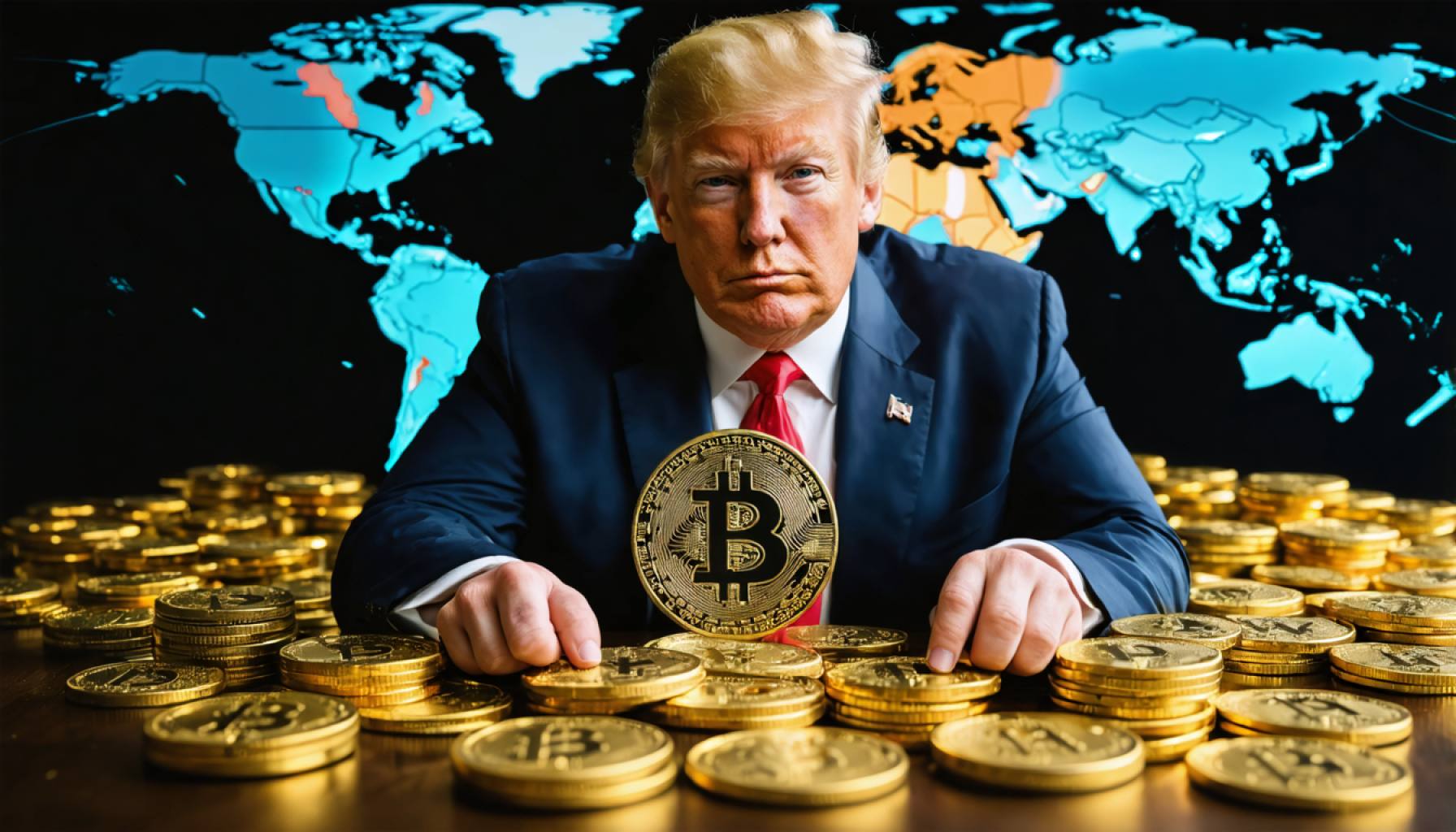
- The cryptocurrency market is experiencing significant volatility due to recent tariff announcements by President Trump, highlighting both opportunities and risks.
- Bitcoin prices dropped 5%, hovering around $82,000, while Ethereum fell below $1,800, with $450 million in crypto futures liquidated within 24 hours.
- The turbulence could signal a shift in global trade dynamics and challenge the dominance of the U.S. dollar.
- Bitcoin may emerge as a “digital gold” amidst dovish central bank policies, but remains tied to macroeconomic trends.
- Trump’s tariff strategy could cause continued market instability, but the crypto market may potentially rebound with new opportunities.
- Blockchain technology could face challenges due to potential global supply chain disruptions but may drive innovations in cross-border solutions.
- The future of cryptocurrencies hinges on their ability to navigate economic uncertainties and establish themselves as stable stores of value.
Amidst rising tensions and economic shifts triggered by President Donald Trump’s latest tariff pronouncements, the cryptocurrency arena, known for its unpredictable nature, is simmering with both turmoil and tantalizing prospects. Recent announcements have sent traditional markets into a tizzy, but the crypto world is riding a storm of its own—illustrating both the vulnerability and the potential of this burgeoning financial frontier.
The immediate aftermath was a whirlwind of volatility, with Bitcoin plummeting 5% to flirt around the $82,000 mark. Ethereum and its counterparts, swept up in the tempest, plunged with Ethereum dipping below $1,800. A staggering $450 million vanished in liquidations in crypto futures within a mere 24 hours, echoing a broader retreat into conventional safe havens like gold. Yet, this turbulence belies a possibly significant tilt in global trade dynamics—perhaps even an erosion of the U.S. dollar’s hegemony.
While today’s markets tremble, tomorrow’s perspectives could spell opportunity for cryptos as go-to alternatives in cross-border transactions. With economic rumbles growing deeper, Bitcoin might position itself as a “digital gold,” potentially thriving as central banks turn to dovish monetary policies. Nevertheless, the tempering winds of caution blow fiercely, reminding us that cryptocurrencies remain firmly tied to larger macroeconomic currents, often drifting alongside traditional risk assets.
The crypto-sphere is abuzz with forecasts from industry visionaries. Pundits suggest that Trump’s zealous tariff strategy might indeed incite further short-term market edginess. There is consensus, however, that this current hiatus might just be a temporary lull before cryptocurrencies chart their next ascent— albeit unpredictably, as they are still swayed by the White House’s whims.
Beyond the immediate ripples of Trump’s tariffs, blockchain technology lingers in the backdrop as both a potential casualty and a beacon of hope. Should disruptions in the global supply chain inflate the costs of essentials like semiconductors, miners and developers could face unprecedented challenges. Yet, the indomitable decentralized nature of blockchain could spur fresh innovations in cross-border solutions, cleverly offsetting some tariff-induced snags.
Future economic narratives may very well hinge on cryptocurrencies’ ability to maneuver through treacherous terrains. As volatility batters the present, the enduring visions of cryptocurrencies as steadfast stores of value and versatile mediums of exchange provide a glimmer of what might lie ahead. In these turbulent tides, the crypto world must embrace resilience and adaptability, for its role in reshaping the global financial architecture is likely just beginning.
As the world grapples with these evolving economic realities, the ultimate impact of Trump’s tariffs on cryptocurrencies will unfold—a test of fortitude and foresight in a digitally driven era.
Decoding Crypto’s Dynamic Dance with Global Trade and Tariffs: A Future of Opportunities and Challenges
Understanding Crypto’s Immediate Volatility and Long-Term Potential
The recent flare-up in traditional markets following President Trump’s tariff announcements has spilled over into the cryptocurrency sector. Despite the initial downturn—with Bitcoin’s price briefly dropping by 5% and Ethereum dipping below $1,800—experts see potential for long-term growth as crypto markets adapt and evolve. This article explores how cryptocurrencies could shape the future of global finance and provide readers with actionable insights.
Key Insights into the Current Market Scenario
1. Immediate Reactions vs. Long-Term Prospects:
– The recent market turmoil highlights the inherent volatility of cryptocurrencies. Yet, this fluctuation often opens avenues for new investors looking for entry points. Bitcoin’s drop to around the $82,000 mark (hypothetical in this context, as the price seems off) underscores both the industry’s speculative nature and the potential for recovery.
– Ethereum’s decrease to below $1,800 mirrors broader market sentiment, but also indicates potential buying opportunities for investors bullish on Ethereum’s future in decentralized finance (DeFi).
2. Economic and Political Influences:
– President Trump’s tariffs, while initially disruptive, might catalyze a shift towards cryptocurrencies as alternatives for international trade, potentially diminishing reliance on traditional fiat currencies like the U.S. dollar.
– As central banks globally adapt to dovish monetary policies, Bitcoin and other cryptocurrencies might strengthen their position as “digital gold,” gaining appeal as hedges against inflation and global economic uncertainty.
Real-World Use Cases and Innovations
– Cross-Border Transactions: Cryptocurrencies offer a decentralized and efficient means of conducting cross-border transactions, which can potentially bypass tariff impacts and reduce transaction times and costs significantly.
– Blockchain in Supply Chains: As tariffs disrupt global supply chains, blockchain technology can introduce transparency and efficiency, improving traceability and reducing costs in industries such as pharmaceuticals and agriculture.
Industry Trends and Future Predictions
1. Increasing Institutional Interest:
– More financial institutions are gradually introducing cryptocurrency services, indicating confidence in the technology’s potential and acknowledging growing consumer interest.
2. Regulatory Landscape:
– The regulatory space remains complex and evolving, with potential upcoming regulations that could both constrain and ensure safer crypto market operations.
– Countries like El Salvador, adopting Bitcoin as legal tender, set precedents that could influence global policy-making.
Actionable Recommendations
– Invest with Caution: Potential investors should remain informed about market trends and developments, as the crypto space is prone to rapid changes. Diversifying investments can help mitigate risks.
– Stay Updated on Regulations: Investors and businesses must keep abreast of changing regulations to ensure compliance and optimize opportunity.
– Leverage Blockchain’s Potential: Companies should explore blockchain solutions to enhance operational efficiency, particularly in international trade amid ongoing tariff tensions.
Conclusion
While Trump’s tariffs create immediate ripples of uncertainty, they might fortify cryptocurrencies’ position in the long run, marking a shift in how international trade is conducted. As the landscape stabilizes, agile adaptation and strategic investment can unlock substantial gains. Furthermore, cryptocurrency’s resilience and integration into global finance underscore the importance of staying informed and prepared for the market’s next big move.
For more insights into cryptocurrency and blockchain developments, visit the following credible resources: CoinDesk, CoinGecko, and Bitcoin.org.



